Have you ever wondered how the lighting in a classroom can impact the learning process? If you’re an educator, school administrator, or even a parent, this is a question that’s worth exploring. Classroom lighting is not just about visibility; it’s about creating an environment that enhances learning and teaching.
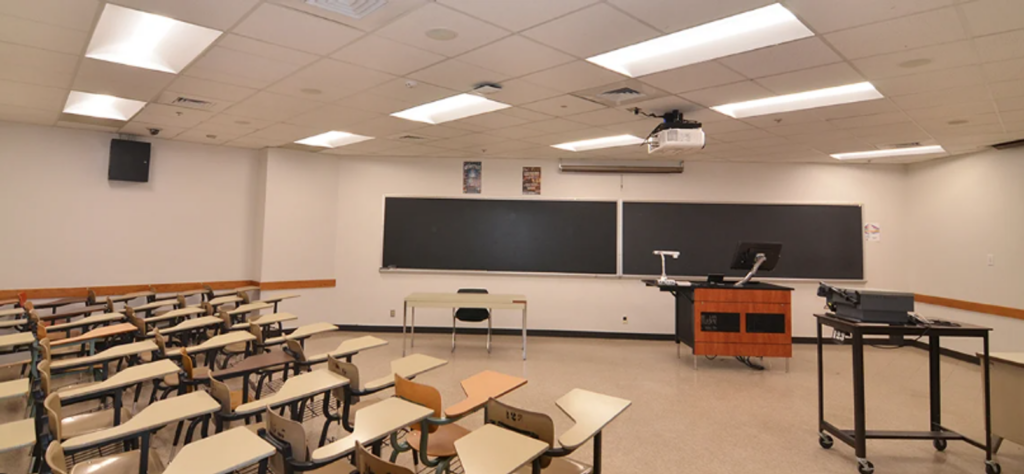
Imagine a classroom where pupils are comfortably engrossed in their learning zone, and educators are seamlessly conducting their lessons in a conducive environment. Picture a space where eye fatigue is a thing of the past and every visual need of teachers and students is met with precision. Sounds ideal, doesn’t it?
But here’s the catch – achieving this ideal scenario is not just about choosing any lighting system. It’s about understanding the subtle interplay between light and learning. It’s about recognizing that inappropriate direct or indirect light exposure can limit students’ ability to learn and hinder classroom activities.
So, buckle up as we embark on a journey to illuminate the significance of optimal lighting in classrooms. We promise it will be enlightening!
What is Classroom Lighting, and Why Does it Matter?
Classroom lighting is the arrangement and application of lights in a classroom setting. It’s not just about making sure everyone can see, but it’s about creating an environment that enhances learning and teaching. It involves the careful selection and placement of lights to ensure that every corner of the room is adequately illuminated and that the intensity of the light is comfortable for both students and teachers.
But why does it matter so much?
Firstly, proper classroom lighting is crucial for the visual comfort of students and teachers. Poor lighting can cause eye strain, headaches, and fatigue, all of which can hinder the learning process. On the other hand, good lighting can reduce these issues, making it easier for students to focus and for teachers to conduct lessons effectively.

Secondly, research has shown that lighting can impact mood and productivity. For instance, natural light has been found to improve mood and energy levels, while the right artificial lighting can increase concentration and reduce hyperactivity in students.
Lastly, with the right lighting design, classrooms can become more flexible and adaptable. Different activities and teaching methods may require different lighting conditions, and a well-designed lighting system can cater to these varying needs.
In summary, classroom lighting is a key element in creating a conducive learning environment. It’s not just about visibility, but also about comfort, productivity, and adaptability.
What are The Main Types of Classroom Lighting?
When it comes to classroom lighting, there are several types of lighting systems that can be used to create an optimal learning environment. Each type has its own set of benefits and is suited to different needs and classroom settings. Here are some of the key types of lighting systems that school classrooms should comprise:
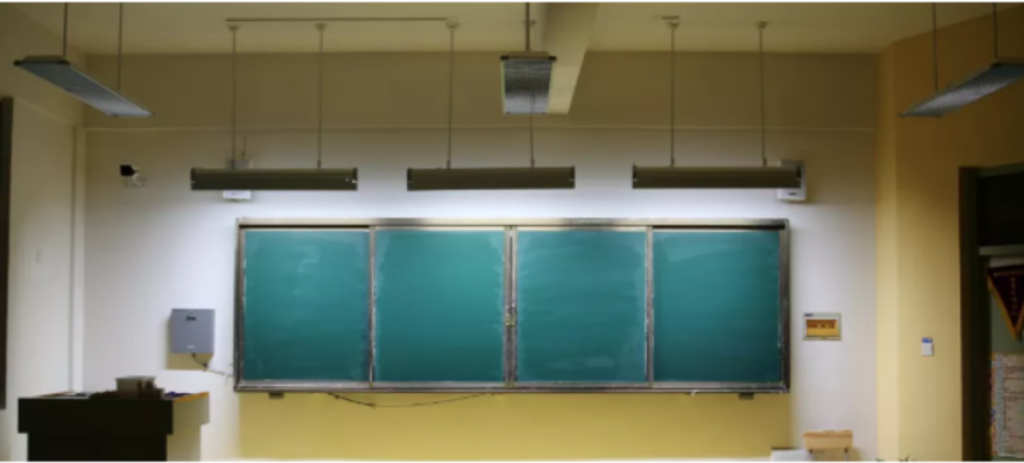
- General or Ambient Lighting: This is the main source of light in the classroom, providing uniform illumination throughout the space. It’s typically achieved with overhead fixtures, often using LED lights due to their energy efficiency and long lifespan.
- Task Lighting: This type of lighting is used to illuminate specific areas where tasks are performed, such as reading areas or workstations. Task lighting can help reduce eye strain and increase focus on specific tasks.
- Accent Lighting: Accent lighting is used to highlight specific features or areas in the classroom, such as artwork or display boards. It helps create visual interest and can also be used to guide attention in the classroom.
- Natural Lighting: Natural light from windows or skylights is also an important part of classroom lighting. Exposure to natural light has been found to improve mood and productivity, and it can also help regulate students’ circadian rhythms.
- Interactive Whiteboard Lighting: Interactive whiteboards require specific lighting to ensure visibility and reduce glare. This can be achieved with carefully positioned lights or with special whiteboard lighting systems.
- Tunable White Lighting: This is a relatively new type of lighting that allows the color temperature of the light to be adjusted throughout the day. Tunable white lighting can mimic the natural progression of daylight, which can help support students’ natural sleep-wake cycles and improve concentration and performance.
In conclusion, a well-designed classroom lighting system should be a blend of these different types of lighting, tailored to the specific needs and layout of the classroom. The goal is to create a flexible, comfortable, and engaging learning environment that supports both teaching and learning.
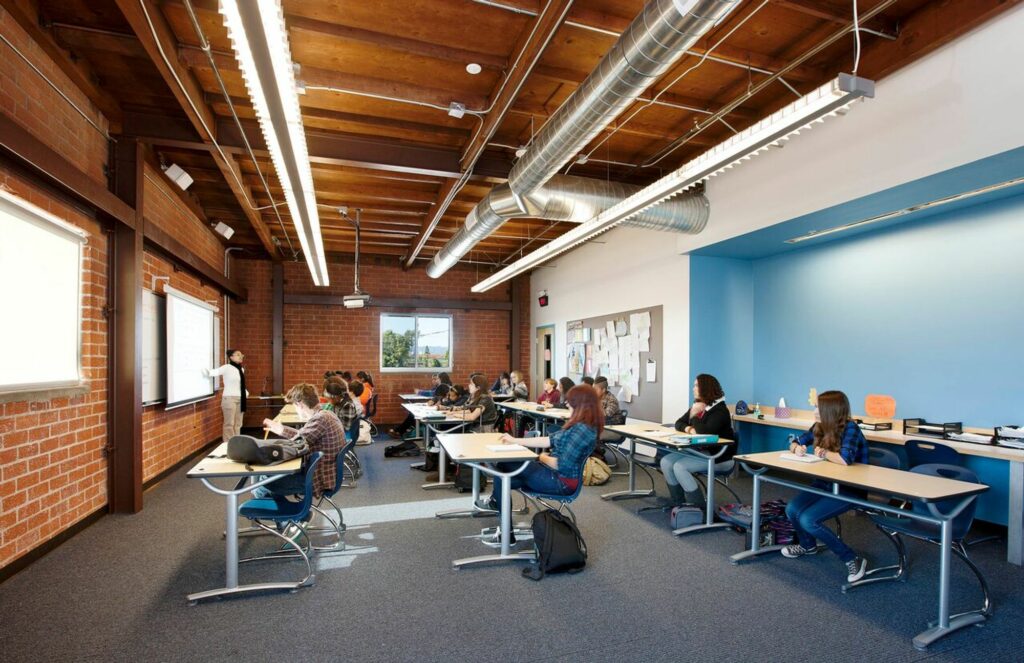
The Impact of Different Lighting Systems
Different lighting systems can have a significant impact on the learning environment in a classroom. Let’s delve into the effects of various types of lighting systems:
- Fluorescent Lighting: Traditionally, many classrooms have been lit with fluorescent lights. While these lights are energy-efficient and long-lasting, they have some drawbacks. For instance, they can cause a flicker that may not be noticeable to the naked eye but can lead to headaches, eye strain, and concentration difficulties in some students. Furthermore, the quality of light produced by fluorescent bulbs is often harsh and cold, which can create an unwelcoming learning environment.
- Incandescent Lighting: Incandescent lights produce a warm, inviting light that can create a comfortable atmosphere in a classroom. However, they are less energy-efficient than other types of lighting and have a shorter lifespan. They also generate a lot of heat, which can contribute to higher air conditioning costs.
- LED Lighting: LED lights are becoming increasingly popular in classrooms due to their many benefits. They are energy-efficient, long-lasting, and produce a high-quality light that can be tuned to different color temperatures. LED lights are also flicker-free, reducing the risk of eye strain and headaches. Additionally, they don’t produce much heat, contributing to a more comfortable classroom environment.
- Natural Light: Natural light is ideal for classrooms as it provides a high-quality, full-spectrum light that enhances mood and productivity. Exposure to natural light can also help regulate students’ circadian rhythms, supporting better sleep and overall health. However, it’s important to control natural light properly to prevent glare and ensure a consistent level of light throughout the day.
In summary, the type of lighting system used in a classroom can significantly impact the learning environment. It’s important to choose a system that not only provides sufficient light but also supports the comfort and well-being of students. LED lighting systems, in particular, offer many benefits for classrooms and are a great option to consider.
Why We Use LED Lighting in Classroom?
Classroom lighting plays a crucial role in creating an environment conducive to learning. While fluorescent lights have been traditionally used in classrooms, they come with several disadvantages that can negatively impact both students and teachers. On the other hand, LED (Light Emitting Diode) lights offer numerous advantages that make them a superior choice for modern classrooms.

Disadvantages of Fluorescent Lights in Classrooms:
- Health Issues: Fluorescent lights can cause distractions, hyperactivity, vision loss, blood pressure spikes, reading difficulties, excitability, and loss of focus and concentration due to their unfiltered illuminance and invisible pulsating light signals.
- Tiredness and Lethargy: The flickering of fluorescent lights can lead to tiredness, lethargy, migraines, and headaches.
- Light Sensitivity: Fluorescent lighting can exacerbate light sensitivity in some students and teachers, leading to symptoms like eye redness, blurred vision, double vision, and light-triggered migraines or headaches.
- Increased Stress Levels: Fluorescent lighting can trigger an unwanted chain of chemical reactions in the body, leading to increased stress levels.
- Eye Problems and Risks: Prolonged exposure to fluorescent lighting can increase the risk of eye disorders, including cataracts, corneal bumps, and macular degeneration.
Advantages of LED Lights in Classrooms:
- Energy Efficiency: LED lights are highly energy-efficient, using significantly less power than fluorescent lights, leading to substantial energy savings.
- Long Lifespan: LED lights have a much longer lifespan, reducing the need for frequent replacements and maintenance.
- Better Light Quality: LED lights provide better light quality with excellent color rendering, consistent and flicker-free light, reducing eye strain and fatigue.
- Flexibility: LED lights offer great flexibility with dimmable lights and tunable white light options, creating a more comfortable and conducive learning environment.
- Less Heat Emission: LED lights emit very little heat, contributing to a more comfortable classroom environment.
- Health Benefits: LED lights do not flicker, do not emit UV radiation, and do not contain mercury, reducing the risk of health issues associated with fluorescent lighting.
- Smart Controls: LED lights can be integrated with smart controls, enhancing the flexibility and efficiency of the lighting system.

In conclusion, the shift from fluorescent to LED lighting in classrooms is driven by the numerous advantages of LED lights. These benefits not only enhance the learning environment but also improve student performance and contribute to sustainability efforts.
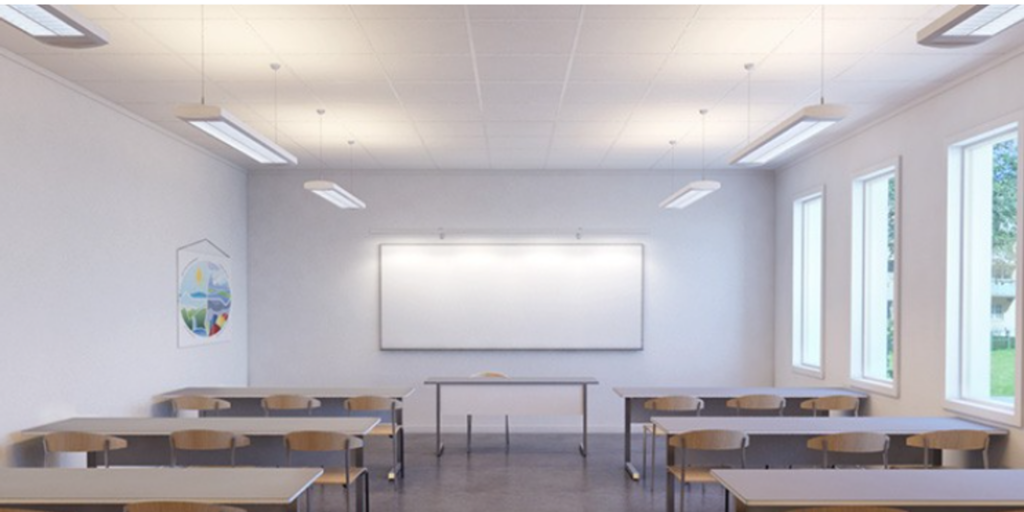
Why Flexible LED Lighting is Required for Modern Classroom?
Modern classrooms are dynamic spaces, hosting a variety of activities ranging from reading and writing to presentations, acting, playing, and testing. Given the diverse range of tasks and the need for adaptability, it’s crucial to have a flexible classroom lighting solution that ensures uniform brightness across the room. This is where flexible LED lighting shines.
LED lighting is highly adaptable, making it an excellent choice for modern classrooms. It can provide uniform illumination for general activities, while also offering specialized lighting for specific zones, such as whiteboards and blackboards. For instance, asymmetrical wall- or ceiling-mounted wall washers can provide excellent presentation and board lighting.
Moreover, LED lighting can enhance the visibility of teachers during presentations. Soft and directed light shining at about 45° ensures that teachers’ facial expressions and body language are clearly visible, enhancing communication and engagement.
While natural daylight is always preferred and utilized where possible, tunable white LED luminaires have been found to yield positive learning results. These lights can adjust their color temperature, mimicking the natural progression of daylight. This feature has been found to enhance students’ concentration, improve test performance, and even reduce hyperactivity.
Furthermore, LED lights are dimmable, allowing for adjustments to suit different activities and times of the day. They also minimize disturbing glare, ensuring proper visual comfort for students.
In conclusion, flexible LED lighting is essential for modern classrooms due to its adaptability, efficiency, and the positive impact it has on the learning environment. It supports the diverse needs of students and teachers, enhances comfort and productivity, and aligns with sustainable practices. As classrooms continue to evolve, LED lighting is set to play a crucial role in shaping conducive and effective learning spaces.

Lighting Requirements for Different Age Groups
The lighting needs of students vary with age. Younger children, aged 7 to 12 years, benefit from a combination of direct and indirect light. The direct portion produces modeling shadows that help the perception of distance and three-dimensional objects, while the indirect portion creates good-quality working light and casts the light onto the walls and ceiling to increase vertical illuminance.
For children past the age of 12, contrast conditions become more important. Excessive amounts of direct light can reduce contrasts, whereas a softer type of light (with more diffusion) will increase them. This is where LED lighting shines, as it can be easily adjusted to provide the right amount of light and contrast.
How to Choose the Right Classroom Lighting Design?
Choosing the right classroom lighting design is a critical aspect of creating an optimal learning environment. The design significantly influences students’ performance, comfort, and overall learning experience. Here are several key factors to consider:
- Light Glare: Glare can cause visual discomfort and lead to decreased concentration and productivity. It’s essential to choose lighting fixtures that minimize glare and distribute light evenly.The Unified Glare Rating is a standard glare rating, and the industry has set a value of 19 for it.
- Veiling Reflections: These occur when light reflects off surfaces, obscuring details and causing visual discomfort. The lighting design should aim to minimize these reflections, particularly on critical surfaces like whiteboards and computer screens.
- Light Distribution: Even light distribution across the classroom ensures that all students have adequate lighting, regardless of their location in the room. This can be achieved by carefully positioning light fixtures and choosing the right types of lights.The optimal lux rating for classrooms has to be 500, and each corner of the classroom should receive an equal amount of light. The minimum illumination rating for classrooms, as per experts, has to be around 60%- 70%.
- Light Flicker: Flickering lights can cause headaches, eye strain, and concentration difficulties. LED lights are a good choice as they provide steady, flicker-free illumination. There’s no specific industry standard mentioned, but it’s important to note that low-frequency flickers might not be noticeable through the eye, they initiate various nervous system responses.
- Direct and Indirect Light: A combination of direct and indirect lighting can create a balanced, comfortable environment. Direct lighting is focused and bright, ideal for tasks requiring high visibility, while indirect lighting softens shadows and reduces glare. It’s important to avoid dark ceilings to prevent casted shadows over tasks and boards inside the classroom.
- Object and Face Modeling: Good lighting design should illuminate faces and objects three-dimensionally, making them easier to see and understand. This is particularly important in a classroom setting where visual communication is key.
- Color Rendering Index (CRI): A high CRI value means that the lights show the true colors of objects. This is important in classrooms, especially in art or design classes where color accuracy is crucial. The natural light you see during the day (i.e., daylight) has a CRI of 100%. Therefore, classroom lighting CRI has to be around 80% at least, but the recommended level of CRI is somewhere near 90% (preferably over).
- Uniform Illuminance: Uniform illuminance ensures that there are no overly bright or dark areas in the classroom, providing a comfortable visual environment for all students. For a uniform horizontal illuminance inside the student zone, minimal shadows and flexibility affect task visibility. The illuminance of different planes, including vertical surfaces, is highly important.
- Color Appearance: The color temperature of the lighting can affect mood and productivity. Warmer colors tend to be relaxing, while cooler colors can increase alertness and concentration.Ideally, classrooms should have adjustable color temperature controls to adapt to different times of the day and different activities.
- Luminance Contrast: Luminance contrast, also known as brightness contrast, refers to the difference in the amount of light emitted or reflected by an object compared to its surroundings. It’s a measure of the difference in perceived brightness between two areas. In the context of lighting design, luminance contrast is important because it affects how well we can see and distinguish objects and details. High luminance contrast can make objects stand out and appear more distinct, while low luminance contrast can make objects blend in with their surroundings and appear less distinct. In a classroom setting, luminance contrast can affect the visibility of educational materials and the overall visual comfort of the space. For example, a black text on a whiteboard has a high luminance contrast, making it easy to read from a distance. On the other hand, if the luminance contrast is too high, it can cause glare, which can be uncomfortable and cause eye strain. Therefore, achieving the right balance of luminance contrast is crucial in classroom lighting design. It’s important to ensure that the contrast is high enough to make educational materials easily visible, but not so high as to cause glare or discomfort.
- Flexibility: As mentioned earlier, different classroom activities may require different lighting conditions. Therefore, having a lighting system that can be easily adjusted or controlled can be highly beneficial.
- Budget: Last but not least, the cost of the lighting system is a key consideration. While initial purchase costs are important, it’s also crucial to consider the long-term operating and maintenance costs.

In addition, the EN 12464-1:2021 standard provides specific lighting requirements for different tasks and activity areas in classrooms. For example, for general classroom activities, the lux level should be 500 with a glare rating of 19 and a uniformity of 0.60. The color rendition should be 80. For black, green, and white boards, the lux level should be 500 with a glare rating of 19 and a uniformity of 0.70. The color rendition should be 80.
**Lighting requirements in EN 12464-1:2021**
| Type of task / activity area | Lux-level (Em) | Glare rating (UGRL) | Uniformity (U0) | Colour rendition (Ra) | Em,z | Em,wall | Em,ceiling | Specific requirements |
|---|---|---|---|---|---|---|---|---|
| Classroom – general activities | 500 | 19 | 0.60 | 80 | 150 | 150 | 100 | Lighting should be controllable |
| Black, green and white boards | 500 | 19 | 0.70 | 80 | – | – | – | Vertical illuminance |
| Projector and smartboard presentation | – | – | – | – | – | – | – | Lighting should be controllable |
| Light on teacher / presenter | – | – | – | 80 | 150 | – | – | Suitable vertical illuminance |
| Display board | 200 | 19 | 0.60 | 80 | – | – | – | Vertical illuminance |
How to Successfully Implement LED Lighting in Classrooms?
Switching to LED lighting in a classroom is not as simple as just swapping out the light bulbs. It requires careful planning and execution to ensure the full benefits of LED lighting are realized. Here are some steps to consider when implementing LED lighting in classrooms:
- Assess Your Current Lighting System: Start with a detailed evaluation of your existing lighting system. Note down the type of bulbs you’re using (fluorescent, incandescent, etc.), the position of the light fixtures, and the quality of illumination. Make sure to observe how shadows are cast in the room and whether there are any dark spots. It’s also worth noting if the existing fixtures are evenly distributed and whether they’re providing uniform lighting.
- Define Your Lighting Goals: Once you’ve got a clear idea of your current situation, it’s time to decide what you want to achieve with your new lighting system. Are you aiming for a more energy-efficient solution, or is your primary goal to improve the learning environment? Maybe you want a system that offers better control over the lighting conditions? Listing down your goals can help guide your subsequent decisions.
- Choose the Right LED Lights: Picking the right LED lights is crucial. Go for high-quality LED bulbs that are known for their excellent color rendering and are free from flicker. Also, consider the color temperature – a neutral white (around 4000K) is often a good choice for classrooms as it provides a balance between warm and cool light.
- Plan Your Lighting Layout: Your lighting design should aim to provide even illumination across the entire classroom. This might involve using a combination of general (overhead) lighting, task lighting, and accent lighting. For instance, overhead LED fixtures can provide general lighting, while task lighting can be added over reading or work areas. Accent lighting can be used to highlight artwork or educational displays.You can recreate the classroom layout within DIALux, including the size and shape of the room, placement of furniture, and color and reflectance of walls, ceilings, and floors. Inputting these details will allow DIALux to more accurately simulate how your chosen fixtures will perform in the actual space.
- Consider Light Controls: Including light controls in your design can bring a new level of flexibility to your classroom. Dimmer switches allow the brightness of lights to be adjusted according to the activity. Timers can turn lights on and off at set times, saving energy when the classroom is not in use. Motion sensors can ensure lights are only on when needed. And tunable white light controls allow you to adjust the color temperature of the light throughout the day.
- Install and Test Your New Lighting: With your plan in hand, you can proceed with the installation. Once installed, perform a comprehensive test of the lighting. Check for uniformity of illumination at different times of the day, and ensure the dimming controls and tunable white lights are functioning as expected.
- Monitor and Adjust as Needed: Post-installation, continue to observe the performance of your new lighting system. Gather feedback from teachers and students to understand their experience with the new lighting. Be ready to make adjustments, such as repositioning a light fixture or tweaking light control settings, to ensure the system continues to meet the needs of the classroom.
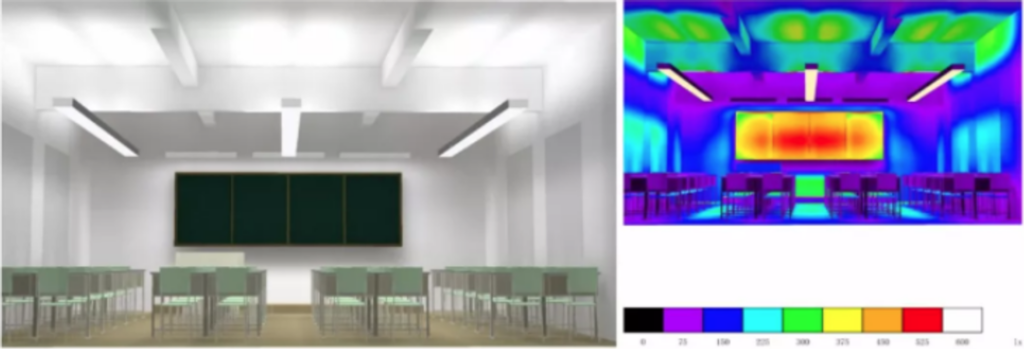
Conclusion
In conclusion, lighting in a classroom is more than just visibility; it significantly influences learning and teaching experiences. The importance of proper classroom lighting cannot be overstated. LED lighting, with its numerous advantages, stands out as a beneficial choice for modern classrooms.
Transitioning to LED requires strategic planning, from assessing the current setup and setting clear goals to planning the layout and making post-installation adjustments. This ensures the creation of a vibrant, engaging learning environment. As a trusted supplier of high-quality commercial LED lighting products, Sinolumi is committed to providing lighting solutions that cater to the unique needs of our clients. Whether you’re a brand manufacturer, distributor, or wholesaler in the market for LED lighting, we’re here to help you illuminate the path to better learning.
